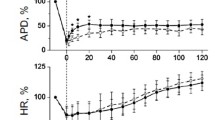Abstract
The vascular reactivity and calcium sensitivity were decreased following hemorrhagic shock. Arginine vasopressin (AVP) was beneficial to endotoxic, infectious/spetic and hemorrhagic shock. Our previous studies found that Rho kinase played an important role in the occurrence of calcium desensitization following shock. It was reported that AVP was with stimulation effect of Rho kinase. So we hypothesized that AVP might have beneficial effect on shock via activation of Rho kinase to regulate the calcium sensitivity and vascular reactivity. Hemorrhagic shock (40 mmHg for 2 h) Wistar rats in vivo were adopted to observe the effects of small dose of AVP on hemodynamics, 24-h survival rate, the pressor effect of norepinephrine (NE) and the contractility of superior mesenteric artery (SMA). Isolated SMAs from hemorrhagic shock rats were adopted to observe the effects of AVP on vascular reactivity and calcium sensitivity and its relationship to Rho kinase with an isolated organ perfusion system. The results show that AVP at the concentration of 0.1 U/kg and 0.4 U/kg significantly improved the hemodynamic parameters and the 24-h survival rate of hemorrhagic shock rats. Meanwhile, these dosages of AVP significantly increased the pressor effect of NE and the contractile response of SMA to NE. Y-27632 (3 μg/kg), a Rho kinase specific inhibitor, abolished the beneficial effects of AVP. In vitro, the calcium sensitivity and vascular reactivity of SMA to calcium and NE were significantly decreased following hemorrhagic shock. AVP at the concentration of 0.5 nmol/L and 5 nmol/L significantly increased the calcium sensitivity and vascular reactivity. These effects of AVP were abolished by Y-27632 (10 μmol/L). Taken together, the results suggest that AVP at 0.1 U/kg and 0.4 U/kg is beneficial to hemorrhagic shock by improving the vascular reactivity, which involves activation of Rho kinase.
Similar content being viewed by others
References
Oliver G. On the physiological of extracts of the pituitary and certain other glandular organs. J Physiol, 1985, 18(3): 27–33
Albert M, Losser M R, Hayon D. Systemic and renal macroand microcirculatory responses to arginine vasopressin in endotoxic rabbits. Crit Care Med, 2004, 32(9): 1891–1898
Dunser M W, Mayr A J, Ulmer H. Arginine vasopressin in advanced vasodilatory shock: a prospective, randomized, controlled study. Circulation, 2003, 107(18): 2313–2319
Dunser M W, Wenzel V, Mayr A J. Management of vasodilatory shock: defining the role of arginine vasopressin. Drugs, 2003, 63(3): 237–256
Raedler C, Voelckel W G, Wenzel V. Treatment of uncontrolled hemorrhagic shock after liver trauma: fatal effects of fluid resuscitation versus improved outcome after vasopressin. Anesth Analg, 2004, 98(6): 1759–1766
Stadlbauer K H, Wagner Berger H G, Raedler C. Vasopressin, but not fluid resuscitation, enhances survival in a liver trauma model with uncontrolled and otherwise lethal hemorrhagic shock in pigs. Anesthesiol, 2003, 98(3): 699–704
Voelckel W G, Raedler C, Wenzel V. Arginine vasopressin, but not epinephrine, improves survival in uncontrolled hemorrhagic shock after liver trauma in pigs. Crit Care Med, 2003, 31(4): 1160–1165
Uehahato M, Ishizaki T, Satoh H. Calcium sensitization of smooth muscle mediated by a Rho-associated protein kinase in hypertension. Nature, 1997, 389(6654): 990–994
Xu J, Liu L M. The role of calcium desensitization in vascular hyporeactivity and its regulation following hemorrhagic shock. Shock, 2005, 23(6): 576–581
Cavarape A, Bauer J, Bartoli E. Effects of angiotensin II, arginine vasopressin and tromboxane A2 in renal vascular bed: role of rho-kinase. Nephrol Dial Transplant, 2003, 18(9): 1764–1769
Liu L M, Ward J A, Dubick M A. Hemorrhagic shock induced vascular hyporeactivity to norepinephrine in select vasculatures of rats and the roles of nitric oxide and endothelin. Shock, 2003, 19(3): 208–214
Liu L M, Dubick M A. Regional diversity of hemorrhagic shock-induced vascular hyporeactivity and the roles of nitric oxide and endothelin: relationship to gene expression of NO/ET-1 and select cytokines in corresponding organs. J Surg Res, 2005, 125(2): 128–136
Zhao K S, Huang X L, Liu J. New approach to treatment of shock-restitution of vasoreactivity. Shock, 2002, 18(2): 189–192
Kai L, Wang Z F, Hu D Y. Opioid receptor antagonists modulate Ca2+-activated K+ channels in mesenteric arterial smooth muscle cells of rats in hemorrhagic shock. Shock, 2003, 19(1): 85–90
Matsui T, Amano M, Yamamoto T. Rho-associated kinase, a novel serine/threonine kinase, as a putative target for small GTP binding protein Rho. EMBO J, 1996, 15(9): 2208–2216
Kimura K, Ito M, Amano M. Regulation of myosin phosphatase by Rho and Rho-associated kinase (Rho-kinase). Science, 1996, 273(5272): 245–248
Li T, Liu L M, Xu J, Yang G M, Ming J. Changes of Rho kinase activity after hemorrhagic shock and its role in shock-induced biphasic response of vascular reactivity and calcium sensitivity. Shock, 2006, 26(5): 504–509
Fleisher S, Kagan E, Grossman N. Multiple effects of arginine vasopressin on prostaglandin E2 synthesis in fibroblasts. Eur J Pharmacol, 2004, 485(1–3): 53–59
Sirintorn Y, Ehab A A, Cheng Y Y. The role of arginine vasopressin in diabetes-associated increase in glucagons secretion. Regulatory Peptides, 2004, 122(3): 157–162
Voelckel W G, Lurie K G, Lindner K H. Vasopressin improves survival after cardiac arrest in hypovolemic shock. Anesth Analg, 2000, 91(3): 627–634
Bauer J, Parekh N. Variation in cell signaling pathways for different vasoconstrictor agonists in renal circulation of rats. Kidney Int, 2003, 63(2): 2178–2183
Malay M B, Ashton R C Jr, Landdry D W. Low-dose vasopressin in the treatment of vasodilatory septic shock. J Trauma, 1999, 47(4): 699–703
Landry D W, Levin H R, Gallant E M. Vasopressin deficiency contributes to the vasodilatation of septic shock. Circulation, 1997, 95(5): 1122–1125
Kawano Y, Fukata Y, Oshiro N. Phosphorylation of myosinbinding subunit (MBS) of myosin phosphatase by Rho-kinase during cell migration and cytokinesis. J Cell Biol, 1999, 147(5): 1023–1038
Author information
Authors and Affiliations
Corresponding author
Rights and permissions
About this article
Cite this article
Li, T., Yang, G., Xu, J. et al. Beneficial effect of arginine vasopressin on hemorrhagic shock through improving the vascular reactivity. Front. Med. China 2, 248–254 (2008). https://doi.org/10.1007/s11684-008-0047-5
Received:
Accepted:
Published:
Issue Date:
DOI: https://doi.org/10.1007/s11684-008-0047-5




